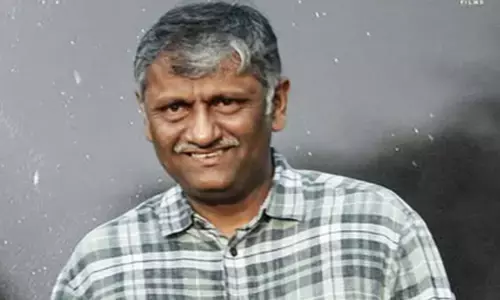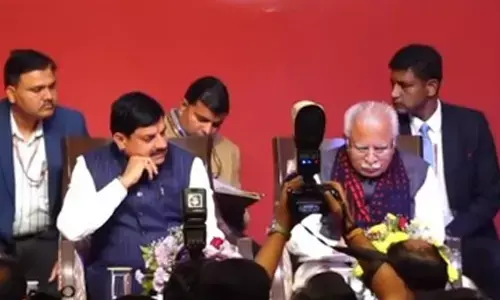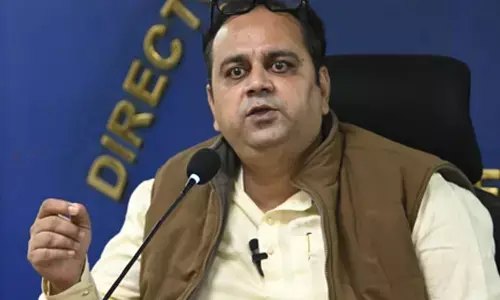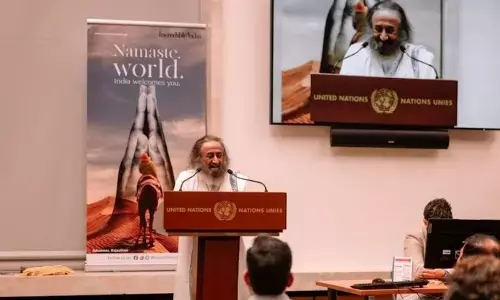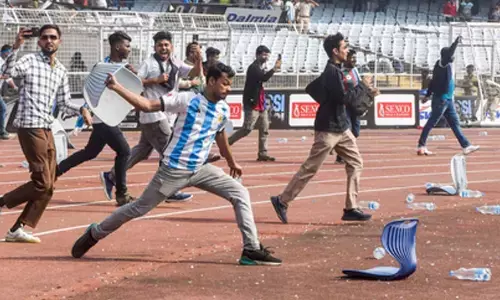A pitched battle for water

Lagaan\' was good. Really good. I watched it several times. It was not just Amir Khan that was good in it. Everyone else was. The movie was gripping. Revolving around cricket, our national passion, this film with its ‘rural poor vs the rulers’ theme is fantastic. It made a lot of money, too.
Lagaan' was good. Really good. I watched it several times. It was not just Amir Khan that was good in it. Everyone else was. The movie was gripping. Revolving around cricket, our national passion, this film with its ‘rural poor vs the rulers’ theme is fantastic. It made a lot of money, too.
'Lagaan - II' is even more gripping. Again, all about cricket. This time around, however, it is the other way round. The makers of 'Lagaan' two just reversed the script. In part-I, it was the villagers who owe the British taxes and they agree for a play-off risking everything. Playing a match is a solution to the problem here. In this part-II cricket itself is a problem.
Now that the Bombay High Court has thought it wise to kick out cricket from the drought-hit Maharashtra, the countrymen may come to their own conclusions. Are parched throats more important than the parched cricket field? A cricket pitch is all about money and hence utmost care is taken.
A farmer is all about politics and hence junked till the next elections. We are talking about 10 crore farm families in this country – and also about rural India and its water needs. Unless an agriculture or a rural emergency is declared and measures adopted to tend to rural India, things would only worsen
Cricket matches being played in parched land. The naysayers are serious about opposing it. The owners, the players and their managers too are serious about it. The IPL - call it Indian Premier League or Indian Paani League – has similar settings. The backdrop of the film matches with that of.. say.. Latur or Marathwada.
Now that the High Court has thought it wise to kick out cricket from the land, the countrymen may come to their own conclusions. Parched throats are more important than the parched cricket field, it ruled. Larger cause of the people could not be ignored. No overriding the same, the HC opined.
It even said that it should be a beginning to avert the use of large quantities of water for purposes other than that of the needs of the public. One could always ask how about the swimming pools. These are made up of more water than needed to maintain a cricket pitch? But, there is no PIL against the same and so for the time being the courts would not deal with it.
While shifting out the matches from Maharashtra may be good for the State, how about other States which are equally parched, if not more? How would they be able to deal with the water problems all the while hosting cricket? Vast areas of Telangana and AP are dry.
So why should there be cricket in the two States? Or in Karnataka, Tamil Nadu, Delhi, Punjab or even Haryana? The last two too faced drought and suffered farmer suicides. Delhi's throat is already dry, though Arvind Kejriwal is publicly posturing that he would send a train daily to Latur with water. Water trains to Latur, Mr Kejriwal ? First it should be water tankers to the 'gullies' of Delhi, sir!
But then, let us not deviate from our subject. So, is banning a solution? Or sending water trains to Latur? (A weirdo was heard mumbling “why not oxygen trains to Delhi” instead of odd-even experiment. Let Kejriwal answer it). Someone even said, “It is a joke. Why would they be needing 60 lakh litres to maintain a cricket pitch. It is grass like everywhere.”
No sir. It is not as simple. It is not simply about water. It means a lot of dedication, sincerity and commitment to maintain one. Let me explain. Cricket is typically played on a grass pitch and will have a various number of pitch positions. The length of an adult pitch is 22 yards, whilst a 'typical' pitch might be 24m (length) x 30m (width).
A cricket pitch should ideally be even throughout, with no undulations or depressions, well consolidated, giving good and appropriate ball bounce, covered with a dense sward of desirable grasses that have good root density and depth. In addition, a well-prepared pitch should ideally be able to withstand the equivalent of three, five-hour games.
To ensure that a cricket pitch is maintained correctly, not only during the playing season but also throughout the whole of the year, a number of individual performance standards are likely to be set. The setting of these performance standards provides a means of objectively assessing the quality of the cricket pitch. Realistically the aim is for a cricket pitch that plays well, is safe and is managed in a cost-effective manner. I am not saying this but the experts.
Pre-season maintenance is important. The work carried out during this period will cover January to April as play will typically commence during the latter part of April or early May depending upon the level of competition. The importance of understanding management and maintenance requirements of different pitch constructions cannot be emphasised enough.
This is an essential prerequisite for good turf management techniques and should be the foundation on which a yearly maintenance programme is based. The most significant and difficult part of pre-season cricket maintenance is rolling. This is usually a blend of art, science and local knowledge.
There is no hard and fast rule about how often and how heavy a roller should be to prepare a pitch for the season. The Institute of Groundsmanship explains the chemical applications that go into it. Spraying, early fertilizer application, scarification and drag brushing are all important.
And these are done meticulously. Their greater worry is earthworms and weeds as both have the potential to damage the pitch. The fertilisers that go into the ground are carefully measured and administered. Watering is done cautiously and under the watchful experts of specialists.
During playing seasons there would be too many complaints right from uneven bounce, inadequate bounce or the ball deviating unintentionally from the desired line etc. An interesting article on rolling appeared in the June 2001 issue of "The Groundsman" titled 'Get back to basics to get rolling results just right' by Alex Vickers, which identifies how rolling increases soil strength in two ways amongst sand dominated soils and clay dominated soils.
He went on to add "rolling increases the number of small pores in the soil. These pores strongly hold onto water and it is this internal cohesion that provides the extra strength in a rolled clay soil when it dries." Irrigation will be required throughout the season to maintain not only a good surface but to allow the soil particles to be squeezed together during the process of rolling.
Then there is end of season maintenance again. It is a cyclical process to keep all lovers of the game in good humour. The amount of nitrogen, phosphate and clay that should go is weighed properly to strengthen the pitch. That is the story of a cricket pitch.
Now compare this to the rural landscape. Who cares for it and who tends to it? It is up to the hungry farmer and his family. No politicians own him up nor is he picked up by any political party as its player. He is neither paid by the government nor any 'owner'. All unto himself and left at the mercy of elements, he looks towards the sky for his succor. The agriculture department is not his groundsman. Nor State government, his roller. In fact, only a pesticide seems to be his friend.
A cricket pitch is all about money and hence utmost care is taken. A farmer is all about politics and hence junked till the next elections. After an economic meltdown in this country in 2008-09, the government announced an economic bailout package of Rs 3 lakh crore. Have you ever seen such a package implemented with the same enthusiasm for farmers?
We are talking about 10 crore farm families in this country. And also about rural India and its water needs. Unless an agriculture or a rural emergency is declared and measures adopted to tend to rural India, things would only worsen. Just revisit Swaminathan Committee recommendations. It has answers to most of the problems. Yes Sir, play cricket, by all means. But do not play with lives of rural Indians.








